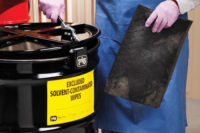Nearly every manufacturing facility uses, stores or otherwise handles hazardous chemicals. Knowing how to manage those chemicals properly helps safeguard employees and the environment.
Although many facilities receive chemicals in bulk and store them in above- or underground tanks, containers are still a common option for materials in smaller quantities. The Environmental Protection Agency (EPA) defines a container as “any portable device in which a material is stored, transported, treated, disposed of, or otherwise handled.” Drums, totes, cans, pails and even bags are all examples of containers that meet this definition and fall under regulation if they contain a hazardous chemical.
Complying with OSHA’s Hazard Communication Standard is a good start to properly managing containers because it helps employees to know and understand any hazards that chemicals in the facility present as well as what they need to do to protect themselves from those hazards. Following EPA’s container management standards builds upon that knowledge and helps facilitate both worker and workplace safety.
Keep containers closed
Many of the EPA’s container management standards fall under the Resource Conservation Recovery Act, (RCRA) which governs the handling, management and storage of hazardous wastes. The EPA’s “closed container” standard (40 CFR 264.173) is one of those regulations. In essence, this regulation says that unless you are adding or removing hazardous waste from a container, it must be kept closed.
Keeping a container closed helps to prevent the waste from leaking or spilling, should the container be intentionally or accidentally knocked over. An added benefit to keeping containers closed is that any fugitive emissions from the wastes in the container will be kept in check. This helps maintain indoor air quality and worker health.
In addition to the closed container standard, the EPA also has a similar standard for Level 1 Containers (26-119 gallons, in light service) that hold wastes with regulated VOC content. Under this standard, containers must be kept closed with a lid that has a continuous seal [40 CFR 264.1086(c)].
Labels and markings
Containers need to be properly marked so that everyone at the facility knows the contents. This is an OSHA requirement for any hazardous material, and an EPA regulation for any hazardous waste (40 CFR 262.34). Properly marking containers helps to avoid the misuse of stock chemicals. It also help to manage wastes properly by preventing unintentional mixing that could lead to dangerous chemical reactions if the wastes are incompatible, or expensive waste disposal costs if non-hazardous and hazardous wastes are mixed together.
Waste containers should be marked with the words “Hazardous Waste” or other words that identify the contents, and the date when accumulation began in the container. When hazardous wastes leave a facility for recycling or disposal, the container must also be properly labeled in accordance with Department of Transportation (DOT) requirements (40 CFR 262.31).
Accumulating wastes
Facilities that generate hazardous wastes need to know their waste generator status, because it determines the length of time that hazardous wastes may be stored onsite without a permit. Large quantity generators (those that generate more than 2,200 pounds of hazardous waste or more than 2.2 pounds of acutely hazardous waste per month) may store containers of hazardous wastes for up to 90 days without a permit.
Small quantity generators (those that generate more than 220 pounds, but less than 2,000 pounds; or less than 2.2 pounds of acutely hazardous waste per month) can store wastes for up to 180 days without a permit (40 CFR 262.34). There are some stipulations that allow longer accumulation times if the wastes must be transported long distances.
Many facilities benefit from EPA’s satellite accumulation rule. This allows wastes to be accumulated at or near the point of generation without triggering the 90- or 180- day storage limitations. Wastes accumulated in satellite accumulation areas must be under the control of an operator, stored in containers that are kept closed and properly marked to identify their contents. There are limits to the volume of waste that can be accumulated at each satellite accumulation area, but there are no limits to the number of satellite accumulation areas a facility may have [40 CFR 262.34(c)].
Inspections
Using containers that are in good condition helps to safeguard the contents and prevent leaks and container failure. Sometimes, however, a faulty weld, spot of rust or other imperfection may be hard to spot. Because of this, the EPA requires containers to be inspected at least weekly to make sure that leaks or other problems are dealt with in a timely manner (40 CFR 264.174).
Secondary containment
Sometimes, primary containers fail. Storing containers in or on secondary containment devices captures leaks and spills so that they do not present safety and environmental problems. The EPA does not mandate what a secondary containment system must look like, however, they do require that it is free of gaps or cracks, compatible with the liquids that could spill and that it has a volume sufficient to contain the total volume of the largest container stored, or 10 percent of the total volume of all containers stored in the secondary containment system, whichever is greater.
Secondary containment systems must also be raised or sloped so that, in the event of a spill, the container does not sit in the spilled waste. If the system is outdoors, the area must be covered to prevent precipitation from entering, or sized to accommodate both precipitation and the volume of liquid that could spill (40 CFR 264.175).
Contingency planning
Large quantity generators of hazardous waste and Treatment, Storage and Disposal Facilities (TSDFs) are required to have a contingency plan. This isn’t a bad idea for any facility. Contingency plans document what actions the facility will take in the event of a spill.
At a minimum, the plan must include any arrangements that have been made with local emergency response agencies, up-to-date contact lists, and the names of any individuals at the facility who may act as emergency coordinators. The plan must also list the actions that the facility will take in response to a hazardous chemical release, facility evacuation plans and the equipment that is available for response efforts (40 CFR 264, Subpart D).
Employees who have been taught to manage containers properly and who understand their roles for both daily operations as well as emergency response will be better able to use, store and manage containers of hazardous chemicals safely and effectively.



